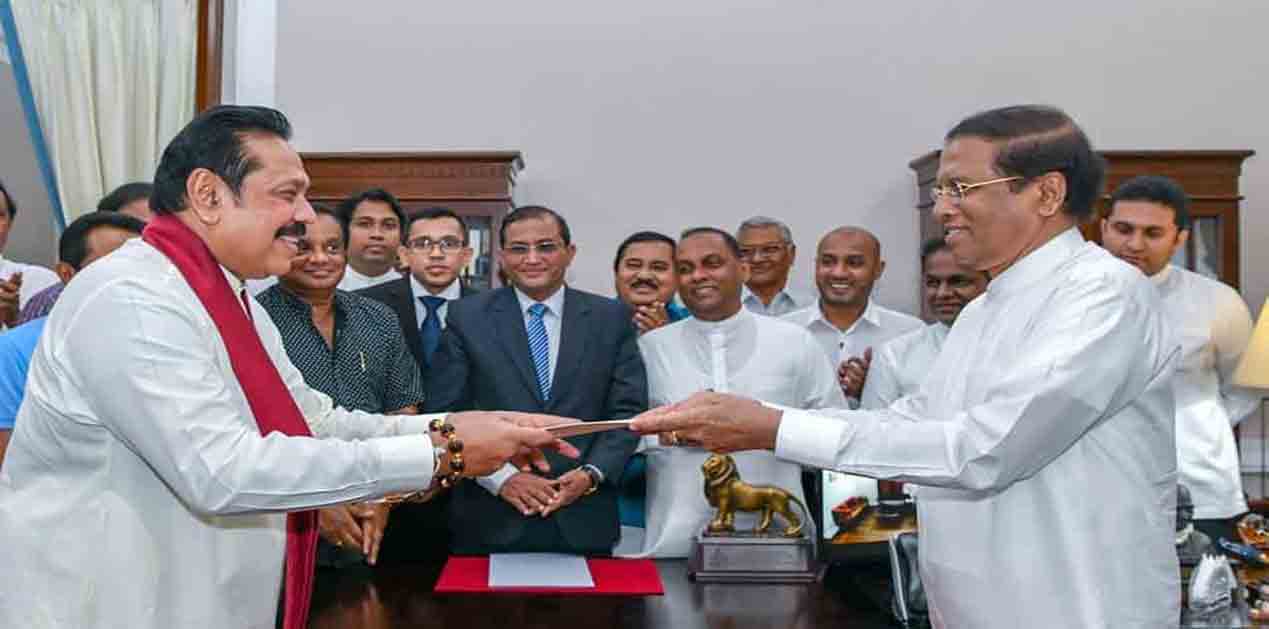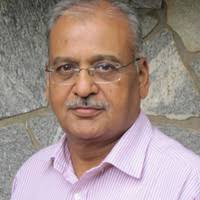President Maithripala Sirisena’s (MS) palace coup of October 25, 2018, aimed apparently at wresting absolute powers, has obviously failed to achieve its objectives, and in its stead, has created more chaos and confusion. The sacking of a sitting Prime Minister, Ranil Wickremesinghe (RW), who enjoyed the confidence of the Parliament, was the trigger that changed the political narrative. This was an unprecedented development. While it was obvious that the relations between President Sirisena and his PM Wickremesinghe had reached a point of no return and the break-up was seemed inevitable, yet the manner and speed of its collapse was more dramatic, as it came sooner than later.
The plan to remove RW from the Prime Ministerial position and the subsequent dissolution of Parliament has backfired on the President. At the end of some moves and counter moves, the Supreme Court stayed the dissolution of Parliament till December 07, 2018. The battle thereafter shifted to the Parliament for political factions to contest their strength on the floor of the House where it should have been done initially. It was obvious that PM Ranil’s United national Party (UNP) remained the single largest party in Parliament during the crisis and with its allies, it had a comfortable majority to retain control of the government. Observers opine that this calculation may have given RW the confidence not to succumb to his dismissal by MS and refuse to move out on the official residence of the PM and insist on floor-test of strength.
The arithmetic was evident for all to judge the UNP’s claims, even after providing for defections and cross-votings. The UNP papered over its internal differences and weathered the storm and stood solidly behind RW. This was despite attempts by MS to offer the prime ministerial post to RW’s colleagues in an attempt to split the party. The UNP has several internal fault lines and challenges including emergence of Sajith Premadasa on the scene as a possible parliamentary party leader. Political observers are of the opinion that the UNP has to address this aspect immediately and prepare itself for crucial hearing at the Supreme Court on December 07, 2018. It has also to be battle ready for the next general elections.
The actions of MS have exposed the fault-lines in the Sri Lankan political scene to a degree not seen before. The Sri Lanka Freedom Party (SLFP) is among the first casualties of the palace coup. With most of its parliamentarians having joined the Sri Lanka People’s Front (SLPP) in the wake of the parliamentary crisis, reducing the once all-powerful SLFP to a mere shadow of its former self. This situation will turn worse when its adherents in the provincial assemblies and local bodies decide to cast their lot with the Sri Lanka People’s Front (SLPP), which is now the political vehicle of former President Mahinda Rajapaksa (MR). The SLFP, which helmed Sri Lanka for considerable part of post-Independence period, will no longer be a major power broker in the country. The popularity of the SLFP had been on the lower trajectory for the past several years and the recent developments have added to its acute discomfort.
The other factor that needs to be flagged here is the fact that the easing out of the SLFP from the seat of power will strongly impact the political fortunes of the Bandarnaike family, the scions of SLFP, and their influence on national politics. Chandrika Bandarnaike Kumaratunga (CBK), former President and erstwhile head of SLFP, is thus likely to be another collateral casualty of the palace coup and it may well be end of the road for her. It will be difficult to imagine a future Sri Lankan political scene without the SLFP and CBK.
There are several other related questions also that need to be addressed in the wake of the recent events. The first one obviously relates to the timing of RW’s dismissal, when grounds for was not well prepared? It is possible that MS mis-read the situation and relied upon assessments that RW had become unpopular and hence could be easily removed from office. It will be recalled here that even CBK had dismissed the RW government in February 2004 without any apparent reasons. CBK had made it known privately that RW had failed to keep her informed about the cease-fire deal with the LTTE and claimed that it was done behind her back. CBK had made attempts earlier to destabilize RW’s United People’s Alliance (UPA). It is another thing that she lamented her decision many years later especially after she lost the control of the SLFP to MR and subsequently got side-lined from mainstream politics for several years. RW lost the April 2004 elections for poor economic performance and MR became the PM and exploited the cease-fire and subsequently defeated the LTTE in 2009.
The battle for appointment of the next Prime Minister is already underway and whoever makes the grade will have to work with MS in this period of uncertainty. Following the current developments, the political future of the MS becomes very uncertain. His image had already been tarnished by his lackluster performance on economic and foreign policy fronts. This was compounded by his ill-advised actions and lack of empathy the electorate thus limiting his ability to take crucial decisions. For MS, the writing on the wall is clear. He has not lived up-to the expectations and promises made in 2015, when he won the Presidency and later that year formed the National Unity Government with RW as his Prime Minister. Further, the euphoria that presided over his assumption of office and groundswell support has evaporated. It remains to be seen how he navigates from here onwards.
The decision to appoint MR as the PM after sacking RW defied politic logic. It was perhaps assumed that MR’s claimed charisma, personal rapport and strong political support, would carry the day in neutralizing the numerical advantage of RW in the Parliament. This did not happen as witnessed in the two successive motions of no-confidence in the parliament, within 72 hours, against the MR led government, and that too by significant margins, which proved that MR did not have the numbers in parliament and the gambit failed. The MS-MR combine was banking on defections from the UNP as also from the minority parties and others. Neither of these materialize despite the many blandishments including monetary inducements. In the Parliament, the two No-confidence motions were defeated by identical margins, RW received 122 votes as against 102 for MR (The UNP has a strength of 106 in Parliament whereas the SLFP has 95).
The present political developments were preceded with anti-India tirade in the news media especially the vernacular press. This happens whenever there is internal political crisis. President Sirisena’s accusations about Indian intervention in Sri Lanka caused unnecessary controversy. India’s relations with Sri Lanka has been subjected to critical analysis and often viewed in a negative sense by observers and opinion makers. The hype which followed leaks to the media of a statement made by MS, at a cabinet meeting, alleging attempts to assassinate him, is one example. The situation returned to normalcy after MS retracted the accusation following a telephonic call to Prime Minister Modi. It reflected the falling standards in public course. Observers applauded India’s response to the internal political developments in Sri Lanka in contrast to that of several western nations.
While there are moves to resolve the political impasse in the island nation, how soon and through what mechanism that would happen, are questions difficult to answer at this stage. Would it be through a Supreme Court led initiative or a craftily worked out political compromise or through mid-term elections, are issues that beg answer. Does India have a role in these? The signals emanating from New Delhi through MEA statements indicate otherwise and so should it be. Maldives experience is a case in point. The people must decide in a democratic manner what they want, and no solution should be imposed from outside. India has always acknowledged Sri Lanka as a long-term economic partner and an opportunity for Sri Lankans to engage in trade, business and commerce in addition to becoming a Buddhist destination and a place for tourists. Sri Lanka is one of India’s top recipients of development aid and assistance over the past two decades.
A section of the Sri Lankan media has time and again raised the bogey of threats that country faces from India. This has to be resolved and those seeking to harm bilateral relations, need to be exposed. There are several factors that need resolution based on mutual consultation including the ones associated with the development of the port and other facilities at Hambantota. Time has come for both sides to address the negativity that characterizes bilateral relations. While both countries have several platforms for consultations including periodic visits at the highest political levels, the need to involve public and civil society participation exists. Communications and new media are powerful contemporary tools to help mould public opinion, disseminate factual information and become bridge between opposing views. It is seen that civil society reactions to the crisis that pervades Sri Lanka has been helpful to defuse the situation and prevent it from worsening matters. There is no denying the fact that the younger generation in Sri Lanka is veering round to the belief that a new force or political grouping is need of the hour to articulate the desire for a new brand of politics.
One way forward to tackling the negativity in India-Sri Lanka relations is building synergies with the powerful Buddhist clergy, whose power, position, influence, advice and direction in matters of national interest is paramount. There is no recollection of high Indian dignitaries having visited Kandy, seeking audience with the Venerable Mahanayakas or other seats of Buddhist spiritual or temporal powers. Indian policy makers and their Sri Lankan counterparts must address this aspect in real earnest. The Odisha based Kalinga Institute could be the catalyst in this case.
The India-Sri Lanka Parliamentary Friendship Association (ISLPPA), formed in 2011, has to be energized to bring dialogue, discussions and perspectives to bilateral relationship. It must buttress the efforts of both governments through various civilian institutions. The parliamentary outreach can be developed and made mand ore vibrant so that it can also become a platform also for provincial law makers, on both sides, to participate in bilateral deliberations. The primary objective of such interactive platforms is to reduce the din, clutter and negativity in bilateral relations and create grounds for better understanding of each-others view point. It would be useful for them to deliberate, address and come up with solutions to resolve outstanding issues that are holding bilateral relations hostage. The way forward on implementation of the provisions of the XIII Amendment and creating confidence building measures to allay fears of the minority communities are two major subjects for consideration by this august body. Another item is to address the ‘historical aberrations’ that seem to have become a major irritant and is used as anti-India propaganda.
India has sufficient influence in Sri Lanka to engage with important stakeholders there to safe guard its interests. It must ensure that other nations desist from exploiting the fragile situation.
(PM Heblikar is Managing Trustee, Institute of Contemporary Studies Bangalore and former Special Secretary, Government of India.)
(The paper is the author’s individual scholastic articulation. The author certifies that the article/paper is original in content, unpublished and it has not been submitted for publication/web upload elsewhere, and that the facts and figures quoted are duly referenced, as needed, and are believed to be correct). (The paper does not necessarily represent the organisational stance... More >>
Image Source: https://www.hindustantimes.com/rf/image_size_960x540/HT/p2/2018/10/28/Pictures/sri-lanka-politics_c2cbbce6-da7c-11e8-9906-75af39aa85f1.jpg











Post new comment